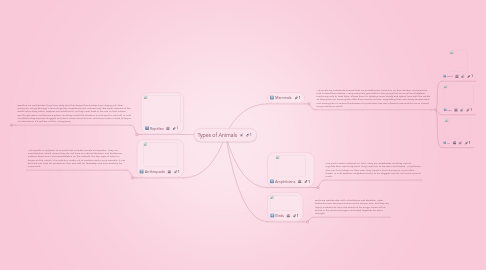Types of Animals
by Jorden Brown


1. Mammals
1.1. Mammals are vertebrate animals that are endothermic, have hair on their bodies, and produce milk to feed their babies. Many mammals give birth to live young that are small and helpless. Producing milk to feed them allows them to develop more slowly and spend time with the adults as they grow up, learning the skills they need to survive. Regulating their own body temperature and having hair of various thicknesses for protection has also allowed mammals to live in almost every habitat on Earth.
1.1.1. Land
1.1.2. Sea
1.1.3. Air
2. Reptiles
2.1. Reptiles are vertebrates, they have scaly skin that keeps their bodies from drying out, their young do not go through a larva stage like amphibians but instead look like small versions of the adults when they hatch. Reptiles are ectotherms, so they must bask in the sun or find a warm spot to get warm and become active, and they must find shade or a cool spot to cool off. In cold conditions they become sluggish and don't move around much, and some enter a state of torpor or hibernation if it will be cold for a long time.
2.1.1. Sea
